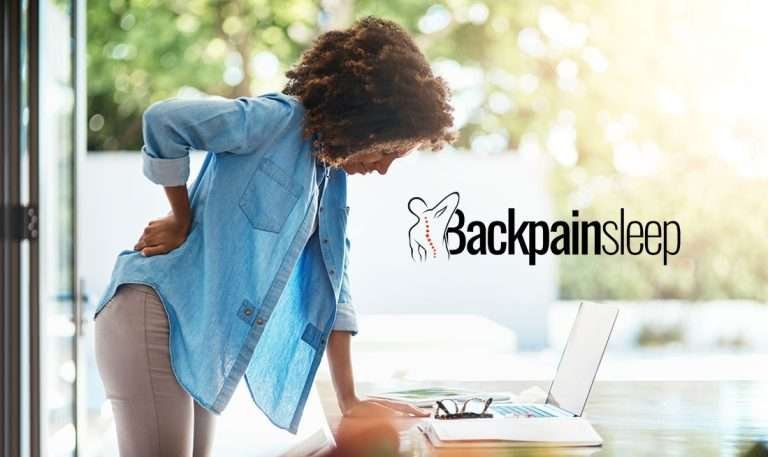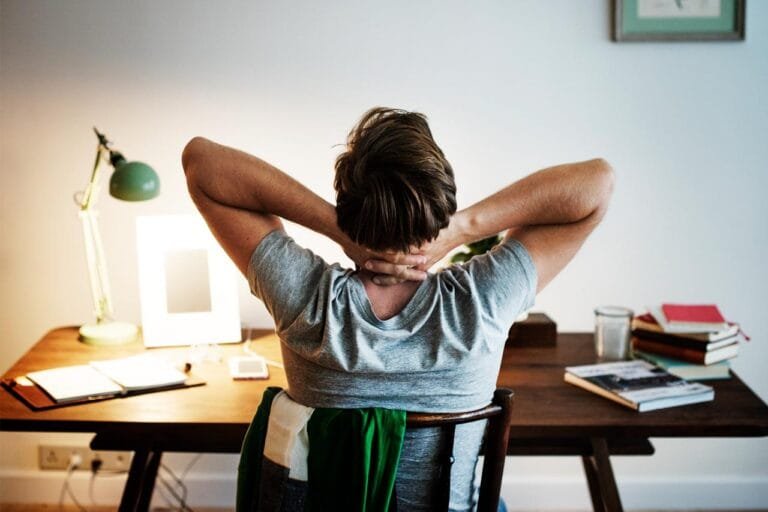Lower back pain is a common health complaint among adults. The pain often disappears after self-care or gentle treatment such as rest and ice therapy. However, it can also persist and cause immense discomfort when localized on the right side of the lower back. If you’re suffering from this type of back pain – have no fear! There are various ways to understand and manage your symptoms for ultimate relief. Medical professionals provide expert insights on how to treat lower back pain effectively.
Join us in discovering practical tips on managing lower back pain by exploring insights from these medical experts who specialize in treating musculoskeletal problems affecting the lumbar spine area.
Causes of Lower Back Pain on the Right Side
Various factors can cause lower back pain on the right side. One primary cause is poor posture, which puts excessive pressure on the lower back muscles and spinal column. Poor posture at work or during long periods of sitting can lead to muscle strains and other related conditions that result in chronic pain. Another common culprit behind lower back pain on the right side is injury from sudden movements or traumatic events like falls or car accidents. Damaging muscles, ligaments, tendons, and bones can cause persistent discomfort and limited mobility. Furthermore, degenerative diseases such as arthritis often trigger inflammation in the joints of the lumbar spine, leading to sharp pains localized on one side of your lower back.
In summary, there are myriad causes for lower back pain on the right side – from poor posture and injuries to more severe medical issues like arthritis. Consulting with medical professionals allows a better understanding of how these conditions occur while providing valuable insights and tips for effectively managing them.
Symptoms of Lower Back Pain on the Right Side
Lower back pain on the right side can manifest through various symptoms. These include muscle spasms, aches that radiate down the leg, stiffness, or even numbness in the lower extremities. Patients may also experience difficulty moving around and performing daily activities due to intense pain. Another symptom of lower back pain on the right side is sciatica – a sharp shooting pain that starts in the lower back and extends into one or both legs. This type of nerve-related problem is usually caused by a herniated disc irritating nerves in your spine.
It’s important to note that these symptoms could indicate other underlying conditions such as arthritis or infection; therefore, it’s always wise to seek medical attention if you’re experiencing persistent excruciating pain accompanied by fever or loss of bowel control. Understanding these early signs can help identify and manage lower back pains effectively for an improved quality of life.
Diagnosis and Evaluation of Lower Back Pain on the Right Side
When it comes to diagnosing and evaluating lower back pain on the right side, medical professionals rely on a thorough medical history and physical exam. The doctor may ask about your symptoms, such as when they started, how often you experience them, and if any activities or movements exacerbate the pain. Additionally, they will conduct tests to check for a range of motion in your lower back, muscle strength and reflexes. In some cases, further diagnostic testing is required to determine the underlying cause of the pain. Depending on individual circumstances, doctors may recommend X-rays or magnetic resonance imaging (MRI) scans to visualize any structural abnormalities contributing to your discomfort. Blood tests are another way for doctors to rule out certain conditions that can cause lower back pain.
Overall, receiving an accurate diagnosis is crucial in developing an effective treatment plan for managing lower back pain on the right side. Working with a healthcare professional specializing in spinal disorders ensures personalized care tailored to each patient’s needs and promotes optimal recovery outcomes.
Understanding the Anatomy of the Lower Back
Understanding the anatomy of the lower back is crucial for finding relief from pain on the right side. The lower back, also known as the lumbar spine, consists of five large vertebrae supporting significant weight and pressure. In between these vertebrae are intervertebral discs that serve as cushions to absorb shock when we move or stand upright. Additionally, joints in the lower back allow us to bend and twist. When structures become damaged or inflamed due to injury or wear and tear, it can cause localized pain on one side of the lower back. Understanding which structure is affected can help with identifying an effective treatment plan. Medical professionals recommend seeking professional help if experiencing chronic or unmanageable pain.
Practicing good posture, engaging in low-impact exercises like yoga or swimming, and making ergonomic changes at work can also aid in managing lower back pain for improved quality of life. By understanding how our bodies work and being mindful of daily activities, we have a better chance of preventing future injuries through proactive care management techniques.
How to Prevent Lower Back Pain on the Right Side
Lower back pain on the right side can be a frustrating and challenging problem to deal with. Fortunately, there are several steps you can take to prevent this type of pain from occurring in the first place. One of the key strategies is maintaining good posture while sitting or standing, mainly when working at a desk for long periods. This involves keeping your spine correctly aligned and avoiding slouching or hunching forward. Another important way to prevent lower back pain on the right side is to stay active and exercise regularly. Strengthening exercises that target the muscles supporting your lower back can help reduce strain and avoid injury. You should also stretch before exercising or doing any strenuous activity and take frequent breaks if you’re spending extended periods sitting down.
Finally, maintaining a healthy weight through proper diet and nutrition can play an essential role in preventing lower back pain on the right side by reducing pressure on your spine. Eating a balanced diet high in protein, vegetables, and whole grains will keep you healthy overall – but managing weight loss must not have drastic measures such as crash diets without a doctor’s consent which could do more harm than good, so discussing weight management options with healthcare professionals would be recommended. With these proactive steps taken into account, it’s possible to maintain optimal spinal health while minimizing discomfort for long-term relief from lower-back pain woes!
Exercises for Lower Back Pain Relief
Exercises are an excellent way to alleviate lower back pain on the right side. They can help you gain strength, increase flexibility and improve posture. One such exercise that is highly effective in relieving right-side lower back pain is the Knee-to-Chest stretch. This involves lying flat on your back and gently pulling one knee toward your chest while stretching the other leg straight. Hold this position for 15-30 seconds, then slowly release, switching legs as necessary. Another beneficial exercise for lower back pain relief is called Pelvic Tilts. Start by lying down with knees bent, feet flat on the floor and arms at your sides. Tilt your pelvis upward towards your belly button while pressing your hips into the floor. Hold this position briefly before lowering your pelvis to the neutral ground again.
In conclusion, managing right-side lower back pain through exercises has been proven time and time again to be an effective means of treatment without medication or surgery typically required if not lacerated any spinal cord bone structure. Also, practice body stretches several times per week. Similar yoga-based movements can help strengthen muscles around sensitive areas like Sciatica nerve discomfort, which connects smaller muscle fibers inter-correlated Consider visiting a healthcare specialist/provider who can evaluate overall health history and suggest viable therapy recommendations that fit accordingly to specific needs being cautious following proper technique during workouts and allowing ample rest & recovery between movements ensuring maximizing benefits with minimal chances of injury-related risks-good luck!.
Physical Therapy for Lower Back Pain on the Right Side
Physical therapy is an effective treatment option for managing lower back pain on the right side. Physical therapy alleviates pain, improves mobility, and prevents further injury. A trained therapist will create a customized plan addressing individual needs and symptoms. Exercise programs range from simple stretches to more advanced movements such as Pilates or yoga. One technique commonly used in physical therapy for lower back pain is called spinal manipulative therapy (SMT). This therapy involves applying force to the spine to restore its natural alignment and relieve nerve pressure. Studies have shown that SMT can be as effective as surgery without the risks associated with invasive procedures.
It’s important to note that physical therapy may not provide immediate relief for lower back pain on the right side. It requires time, effort, and dedication to see significant results. However, consistency pays off as patients who stick with their routine typically experience long-term improvement in their symptoms compared to those who do not participate in rehabilitation.
Chiropractic Care for Lower Back Pain on the Right Side
Chiropractic care is an effective treatment option for lower back pain on the right side. Chiropractors use a hands-on approach to manipulate and adjust the spine, helping to alleviate pressure on nerves and reduce inflammation that can cause pain. They also employ various therapies such as heat or ice therapy, electrical stimulation, massage, and stretching exercises to speed healing. Chiropractic care is beneficial because it treats the root cause of lower back pain rather than masking symptoms with medication. Additionally, chiropractic adjustments are non-invasive, drug-free alternatives that do not pose any serious risks or complications compared to surgical interventions or prescription drugs.
It’s important to note that chiropractic care alone may not always be enough to alleviate chronic lower back pain. With proper management from qualified experts like chiropractors working alongside dedicated patients – relief from this debilitating ailment has never felt closer! It’s best when used with other treatments, such as physical therapy or exercise routines designed by specialists who understand your medical history and lifestyle factors contributing to your condition.
Acupuncture for Lower Back Pain on the Right Side
When managing lower back pain on the right side, acupuncture has become a popular alternative therapy. This traditional Chinese medicine technique involves inserting thin needles into specific points on the body, stimulating energy flow and promoting natural healing. Acupuncture is believed to help alleviate pain by releasing endorphins and reducing inflammation in the affected area. Studies have shown that acupuncture can significantly relieve lower back pain, with some patients experiencing long-term improvement. One study found that acupuncture was more effective than conventional treatments, such as medication for treating chronic low-back pain. If you’re considering acupuncture as a treatment option for your lower back pain, seeking a licensed acupuncturist with experience working with this condition is vital. With proper care and consultation, acupuncture may relieve your symptoms.
Medications for Lower Back Pain on the Right Side
Medications can offer relief for lower back pain on the right side. Nonsteroidal anti-inflammatory drugs (NSAIDs) such as ibuprofen, naproxen, and aspirin are commonly used to reduce inflammation and relieve pain. Muscle relaxants such as cyclobenzaprine, baclofen, or tizanidine can also help ease muscle spasms that often accompany lower back pain. In some cases, opioids may be prescribed by a physician for short-term use when other medications fail to provide adequate relief. However, it is important to note that opioid use carries potential risks of addiction and other adverse health effects. As such, physicians will typically only prescribe these medications when necessary and with close monitoring.
It’s crucial to speak with your healthcare provider before taking any medication for lower back pain on the right side since specific individuals may have contraindications or adverse reactions depending on their medical history or current medication regimen. With proper guidance from your healthcare professional combined with restorative therapies such as physical therapy or massage therapy, however, you can achieve optimal results in successfully managing your symptoms of lower back pain on the right side soon enough!
Injections for Lower Back Pain on the Right Side
When managing lower back pain on the right side, injections can be an effective option for many patients. Corticosteroids and epidural steroid injections are commonly used to alleviate inflammation and reduce pain. These injections deliver medication directly into the affected area, targeting the source of your discomfort. While injections can relieve lower back pain, they also have risks and potential side effects. It’s important to discuss any concerns you may have with your healthcare provider before deciding if this treatment is proper for you.
Additionally, it’s important to note that while injections can help manage symptoms in the short term, a comprehensive approach involving lifestyle changes like exercise and proper posture is essential for long-term neck health. By understanding all your options for treating lower back pain on the right side, you can make informed decisions about your health and well-being.
Surgical Options for Lower Back Pain on the Right Side
When other treatments haven’t provided sufficient relief, surgical options may be considered for lower back pain on the right side. One possibility is a discectomy or microdiscectomy to remove a herniated disc compressing nearby nerve roots. In more severe cases, spinal fusion surgery can attach two vertebrae and permanently stabilize the spine.
Before opting for surgery, discussing potential risks and benefits with your doctor thoroughly is essential. Depending on your case, you may also need imaging tests like X-rays or MRI scans to determine the root cause of your pain. By understanding various treatment options and working closely with medical professionals, those experiencing lower back pain on their right side can take proactive steps toward finding long-lasting relief.
Alternative Treatments for Lower Back Pain on the Right Side
Alternative treatments for lower back pain on the right side can provide relief in addition to traditional methods. One alternative method recommended by medical professionals is chiropractic care. Chiropractors use hands-on spinal manipulation or adjustments to align the body properly and alleviate pain. This treatment also helps increase flexibility and range of motion and reduce inflammation. Another alternative therapy that may be effective for managing lower back pain on the right side is acupuncture. Acupuncture has been shown to help many patients experience relief from their chronic pain conditions, such as lower back pain. By inserting thin needles into specific points in your skin, acupuncturists aim to stimulate your nervous system and promote natural healing processes within your body.
In summary, alternative treatments like chiropractic care and acupuncture have proven records of effectively reducing symptoms of lower back pain on the right side while improving quality of life without any adverse effects associated with prescription medications. Seeking advice from a healthcare provider before beginning any new therapies could ensure safer outcomes when interested in trying these approaches yourself!
Lifestyle Changes for Lower Back Pain on the Right Side
Lifestyle changes can be incredibly effective when managing lower back pain on the right side. One of the most important things you can do is stay active and exercise regularly. This may seem counterintuitive when experiencing pain, but low-impact activities like yoga, swimming, or walking have alleviated symptoms. Maintaining a healthy weight is also crucial, as carrying extra pounds strains your lower back muscles. Another critical change you can make is improving your posture. When sitting or standing for long periods, ensure your spine remains neutral with good support from chairs or shoes. Avoid slouching at all times, as this puts unnecessary pressure on your joints and muscles, which could worsen any pain experienced in the lower back region.
It’s worth noting that reducing stress through relaxation techniques such as mindfulness meditation or deep breathing exercises can go a long way when trying to manage pain levels caused by lower back problems.
Overall, incorporating these small but powerful changes into daily routines goes a long way toward mitigating any discomfort in the future while improving overall well-being too!
Coping with Chronic Lower Back Pain on the Right Side
Coping with chronic lower back pain on the right side can be daunting. It often interferes with daily activities such as walking, sleeping, or even sitting for extended periods. However, there are several strategies that you can use to alleviate your symptoms and improve your quality of life. One approach is through physical therapy, which aims to strengthen muscles in the lower back while reducing inflammation and easing discomfort. Another strategy involves cognitive-behavioral therapy (CBT), which helps individuals cope psychologically with the pain by changing their thoughts, behaviors, and emotions toward it. Additionally, anti-inflammatory drugs or muscle relaxants may provide relief but should only be taken under medical supervision.
Self-care practices like maintaining a healthy weight or incorporating low-impact exercises into your daily routine can also help manage chronic lower back pain on the right side. Remember to consult medical professionals for advice tailored to your needs for long-term relief from this health challenge!
Work-Related Lower Back Pain on the Right Side
Work-related lower back pain on the right side is particularly tricky for many who work physically demanding jobs. Whether it be construction workers or nurses, those who rely heavily on their backs throughout the day risk developing chronic discomfort that can debilitate and significantly impact one’s overall well-being. This type of pain usually develops gradually after weeks, months, or even years of repeated strenuous activity or poor posture. To cope with this pain effectively, it’s essential to take immediate action by adopting proper lifestyle habits, such as stretching before and after any physical activity and maintaining good posture while standing, sitting, or walking. Beyond these measures — which serve as prevention techniques — if you’re already suffering from work-related lower back pain on the right side, medical professionals provide invaluable expertise in managing your symptoms best.
Overall understanding of what causes this kind of lower back pain coupled with professional advice on experimental treatments like medications, hot/cold therapy, and exercises targeted at strengthening core muscles can help sufferers find long-lasting relief to continue performing their daily activities without undue stress.
Travel and Lower Back Pain on the Right Side
Traveling can be an exciting and enriching experience, but it can also aggravate existing health conditions, such as lower back pain on the right side. The discomfort from sitting for prolonged periods in a cramped plane or car seat, carrying heavy luggage, or constantly standing in long queues can trigger intense episodes of pain. Fortunately, there are several strategies that you can employ to prevent further damage to your spine while traveling.
Managing lower back pain requires a multidisciplinary approach that addresses its physical, psychological, and social aspects. These include taking frequent breaks to stretch and walk around, using lumbar support pillows or cushions, wearing comfortable shoes and clothing that allows free movement, and practising good posture. Seeking medical advice from qualified professionals is crucial in diagnosing the underlying causes of your symptoms, such as herniated discs, arthritis, or muscle strain. From there on, doctors may prescribe medications like nonsteroidal anti-inflammatory drugs (NSAIDs) or muscle relaxants, depending on the severity of the condition.
In other cases where conservative treatments fail to alleviate the pain, surgical intervention might be necessary. Therefore, it is essential to consult with a doctor before any treatment plan commences; every patient’s situation differs.
Sleeping Positions for Lower Back Pain on the Right Side
Adjust your sleep positions and bedding for better restorative sleep instead of tossing and turning throughout the night due to discomfort. One of the most effective ways to alleviate lower back pain on the right side is through proper sleeping positions. Sleeping on your stomach should be avoided as it causes your spine to twist in an unnatural position, leading to further discomfort. Instead, consider sleeping on your side with a pillow between your legs to reduce pressure on the lower back and hips. Medical professionals also recommend using a firm mattress that correctly supports the spine while reducing pressure points. This helps ensure that the muscles surrounding the lower back are not stressed while asleep, thus preventing any unnecessary tension or strain.
In conclusion, managing lower back pain requires lifestyle adjustments, such as strictly adhering to healthy sleep habits. These may seem minor but can significantly impact when practiced consistently over time. Future articles shall provide additional tips regarding alleviating this particular condition both naturally and medically, thereby providing readers with helpful solutions for their unique situations.
When to Seek Emergency Care for Lower Back Pain on the Right Side
If you’re experiencing lower back pain on the right side, listening to your body and seeking medical attention is essential. Specific symptoms indicate a more serious condition and require immediate attention, such as persistent pain that doesn’t improve with rest or mild treatments, numbness or weakness in one or both legs, loss of control over bladder or bowel movements, fever, and other signs of infection. These symptoms may indicate a herniated disc or spinal fracture, which can be very serious. Trusting your instincts and seeking medical attention if experiencing these symptoms is essential.
Certain risk factors increase the likelihood of developing lower back pain on the right side, including age, being overweight or obese, having poor posture, and lack of exercise. If you have any underlying conditions that affect your spine or joints, such as arthritis, this can also contribute to back pain. Talking with a healthcare professional for personalized advice on preventing and managing this pain is always best. Taking care of your body and seeking medical attention when necessary, you can avoid potential complications and feel better overall.




